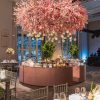Muslim marriage ceremonies symbolize the new union of the couple with both their families and faith. Prior to departing the ceremony location, the newlyweds receive an outpouring of presents and blessings.
The wedding ceremony is followed by a meal, known as the arsi mushraf. The bride and groom are seated together, with their heads covered in veils or scarves, and a mirror and Quran placed between them.
Heena or Mehndi
Heena or Mehndi is a tradition that is widely practiced in many Islamic nations. It is a celebration held before the wedding, with close friends and family. Special artists apply henna paste to the bride's hands and feet, creating designs that simultaneously protect and adorn her.
Henna is derived from the plant Lawsonia inermis, which grows in Africa and India. It can be used as a natural hair dye or as a skin conditioner. The paste is mixed with water to create a rich, red tint that lasts for a few weeks.
A mehndi party is held to celebrate the upcoming marriage and is usually held a few days before the wedding. The henna party is also a great opportunity for women to bond with each other.
In a mehndi party, the bride is adorned with a variety of designs on her hands and feet that symbolize various blessings, luck, joy, love and more. These designs may be a Hindu god, nature elements or symbols from a different culture.
After the henna is applied, the bride's parents and friends present the bride with gifts such as colorful dupattas, perfume bottles, small beaded bags and bangles. These gifts symbolize the upcoming marriage, as well as love and loyalty between the bride and her family and friends, says Lili Marsh, founder of Inspired Karma Weddings & Events in central California.
She adds that the henna is made from a plant called Lawsonia inermis, which can be used as a natural hair dye, or as a skin conditioner. The paste that is applied to the hands and feet is made from the dried leaves of the plant, which is processed into a thick, pliable paste for applying to the skin.
Several different styles of henna designs have emerged throughout the world, and in different cultures. In Morocco and Pakistan, for example, the designs are more geometric, while in India, the patterns are more intricate.
Henna is a decorative body art that dates back to thousands of years. The paste for the henna is made from the leaves of the Lawsonia inermis plant, which can be grown in hot and dry conditions.
Arsi Mushraf
One of the more memorable aspects of an islamic wedding is the after party. After all the shenanigans have been tamed, it’s time to toast the happy couple with some wine and a hearty meal. The best way to do this is with an appropriately themed cocktail or two. The night is rounded off with a well-deserved dinner in the company of the bride and groom’s closest family and friends.
The next day the good times roll again. And of course, this is where the aforementioned cocktail is on tap. Aside from the obvious food and drink pairings, there’s also a lot of socializing, including a well-deserved round of golf for the groom. It’s a whole new ballgame for the couple and their guests. It’s the kind of bonding that will last a lifetime.
Walimah
There are two important parts of an Islamic wedding - the nikah and the walima. Hence, it is crucial to understand the cultural implications of both these ceremonies.
The walima, or the marriage feast, is the Sunnah of our beloved Prophet (Peace and blessings be upon him). It is an outward expression of appreciation for the couple, and a way to publicize their union.
It is a great opportunity to bring the couple's friends and family together to strengthen their bonds. It also helps to make the islamic marriage official.
According to Islam, the invitation for the Walima celebration should be extended to family members, relatives, friends, colleagues, scholars, pious people, and others. It is wrong to invite only rich people or those from the upper class, since this is a haram practice.
Traditionally, the groom organizes the Walima reception and sends out invitations to his parents, siblings, and other family members. Usually, it is a small gathering in his house or a public venue.
In modern times, however, the bride's family can chip in and help with the arrangements. The food and decor of this ceremony are typically lavish and spectacular, and the guests are treated like royalty.
The walima is the last of the post-wedding ceremonies, and it occurs four days after the wedding. It is a time when the newly married couple visits their bride's family and gets showered with gifts. It is a very emotional and bittersweet moment for the bride, who is about to say goodbye to her childhood home and move in with her new husband.
Many Muslims have a custom of inviting their family and friends to the walima, and they will offer their du'as as they share a meal. They will also make a wish for the couple.
It is recommended for all Muslim families to hold a walima, but it is not mandatory. This is because it can be a financial burden for some.
The walima is the last ceremony of an islamic wedding and it concludes with a rukhsati, which is a farewell toast for the couple. It is also a time for the guests to show their gratitude and enjoy the moment. This is a very special occasion that should not be missed by anyone who plans to get married in Islam.
Chauthi
The islam wedding toast is an important part of a Muslim ceremony. It is a chance for both the bride and groom to say their love and blessings to each other.
This is a very beautiful part of the wedding process. It begins with a procession known as the Baraat, where the bride’s family and friends walk through the streets in a spectacular display of cheer and enthusiasm. The baraat is led by a band of musicians, and it is loud and colorful.
As the baraat moves closer to the bride’s home, they are given a welcome and a sherbet drink from her brother or other close family member. It is a lovely gesture that makes the groom feel very comfortable and happy, even before he enters the venue.
The baraat is then escorted to the wedding location where the bride’s family greets them with warm wishes and sprinkles ittar or rosewater on them, creating a festive atmosphere. They also offer the groom a delicious sherbet drink to make him feel better.
After this, the bride and groom sign a marriage contract (Nikahnama) that lists all the duties and rituals they must adhere to as an islamic couple. This is signed by both the bride and groom, and at least two witnesses must be present for it to be valid.
Once the Nikahnama is signed, the Maulvi recites a religious speech. It is called Khutba, and it is based on Quranic verses which are essentially equivalent to the marriage vows.
It is then followed by duruds, in which elders shower their blessings on the newly married couple. They pray for them and wish them long lives together, a lifetime of happiness and prosperity, and that they grow strong and healthy.
Finally, the Maulvi reads a passage from the Quran that is similar to the wedding vows. The bride and groom should not repeat these vows, but listen to them.
A few days after the islam wedding, the bride visits her parents’ house for the first time as a married woman. This is a very special occasion as the parents shower her with gifts and take her to a lavish lunch. It is a very sweet and emotional moment for the newlyweds.







